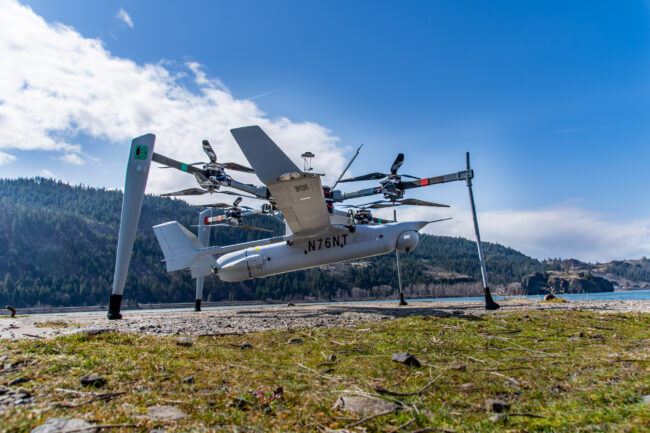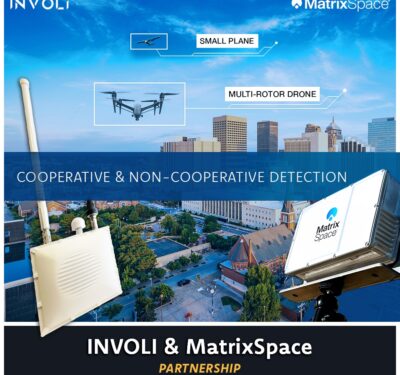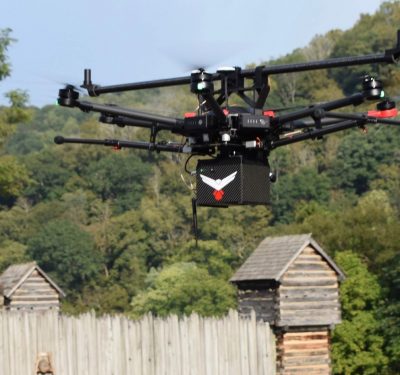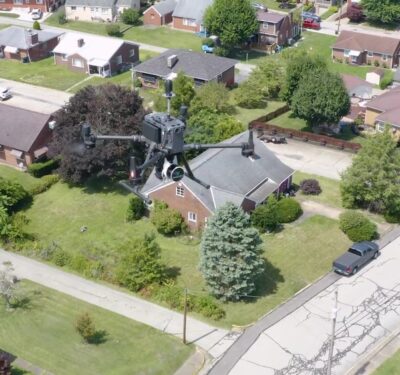
On the ground, it looks like a giant spider pouncing on its prey. But once airborne, Insitu’s latest VTOL system supports a unique paired solution that’s being offered to the U.S. Navy and other customers.
In this iteration, Insitu’s Flying Launch and Recovery System (FLARES) octocopter is a VTOL mothership that launches the company’s Integrator fixed-wing vehicle. Integrator itself is essentially unchanged, but using FLARES provides maximum payload capacity and endurance of 40 pounds and 16 hours—one customer recently ran a 25-hour operational sortie with Integrator. FLARES’ power flexibilty, robustness and redundancy can handle challenging weather conditions while performing signals intelligence, electronic warfare and other missions.
The runway-independent combination also spares users from having to deploy complex launch and recovery equipment.
The mated system is being spotlit on April 3 at the start of Sea-Air-Space, the Navy League’s global maritime exposition, at National Harbor, Maryland. A few days before its debut, Insitu Vice President, Engineering Justin Pearce fleshed out its evolution and operation.
FLARES has gone through eight-plus years of development, Pearce said, including with Insitu’s million-plus fight-hour ScanEagle UAS. “We have pneumatic launchers and vertical arresting ropes called SkyHook that have done really well for our customers. But we recognize the need for mobility and to be more expeditionary. Our customers’ requirements seem to be driving us to longer endurance, more SWaP [size, weight and power] and, obviously, with the national defense strategy’s pivot to the Pacific, mobility off ships with that long endurance. Integrator’s clearly the platform we’d leverage there.”
VTOL Virtuosity
The 12-year Insitu veteran described how the system deploys. Carrying Integrator, FLARES takes off vertically, rises to 500 or so feet, dashes forward, and then releases Integrator into fixed-wing flight. “The recovery,” Pearce added, “is similar if not identical to our current method, with a vertical rope for arresting the vehicle in flight. With that rope tethered to the deck, FLARES climbs 300ish feet, the aircraft approaches from whatever direction it needs to, recovers on that rope, and then is oriented vertically as it’s lowered back down.” The process also attenuates shipboard motion.
FLARES itself isn’t a new concept, but Insitu has worked with launch and recovery specialists Hood Tech Mechanical to develop its VTOL applications. “In combination with Integrator, it offers incredible endurance and allows us to operate off relatively small decks,” Pearce said. We’re emphasizing Integrator’s max takeoff weight of 165 pounds—you can imagine that allows a significant increase in both fuel and or payload, and therefore endurance or capability.” Multiple payloads can be used.
There’s also the Integrator Extended Range (ER), a SATCOM-enabled version. “We replaced the nose module that today would have the EO/IR or other sensor with a radio-slash-datalink for SATCOM communications, and the EO/IR sensor is placed in the center-of-gravity bay,” Pearce said. The package can operate beyond line of slight up to 300 to 500 nautical miles, within the footprint of the geosynchronous satellite spot.
Current users of Integrator who operate standard launch and recovery equipment, Pearce said, could buy the VTOL portion and add it to their current kit. New customers could purchase Integrator VTOL as a standalone system. “It’s really mix and match, and leverages our modularity.”
Pearce summed up the case for FLARES. “We believe there’s a market for long-range long-endurance platforms capable of multi-mission up to and including targeting. And our belief is that it’s going to need to come from the sea, given the set of threats America and her allies face. To do that, we believe you have to have no-compromised VTOL. And that’s what FLARES gets you: amply-sized, safe VTOL while retaining all the investment in the Integrator platform. Because of the way we launch, we believe that you’re going to have a notch above sea state or ship motion compared with other platforms.
“We’re going to see high seas and long endurance as a future, and we’re ready to support that.”






